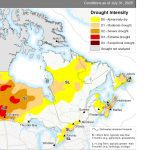For the week ending Feb. 8, western Canadian feeder cattle markets were hard to define.
Many auction barns did not hold sales last week due to adverse weather in Western Canada. As well, the auctions that did have sales had lower volumes.
Western Canadian feeder cattle prices were down sharply early in the week, but values were creeping back up by Friday. Uncertainty over U.S. tariffs contributed to the softer tone early in the week.
Read Also

Alberta eases water access for riparian restoration
Alberta government removes requirement for temporary diversion licence to water plants up to 100 cubic metres per day for smaller riparian restoration projects
On Feb. 5, Alberta packers were buying fed cattle on a dressed basis at $460-$465 per hundredweight. Alberta prices have strengthened by $15-$20 per cwt. over the past couple of weeks. Using a 60 per cent grading, this equates to a live price of $276-$279 per cwt. delivered. Break-even pen closeouts are around $262 per cwt.
The healthy margin structure has enhanced buying enthusiasm and been supportive for the feeder market. The prices below are updated feature sales from the week ending Feb. 1. We believe this is more representative of the overall market.
In central Alberta, larger frame lower flesh tan mixed steers averaging 1,000 pounds on light grain and silage diet with full processing data sold for $353.
At the Lloydminster sale, Simmental based steers averaging 905 lb. left the crowd gasping by selling for $386. Northwest of Winnipeg, Simmental blended heifers with medium to lower flesh levels averaging 926 lb. sold for $334.
In central Saskatchewan, larger frame Angus cross steers with lighter butter levels with a mean weight of 835 lb. were last bid at $390. In the same region, lower flesh Simmental based heifers averaging 860 lb. were last bid at $352.
Southeast of Calgary, larger wide frame Limousin steers weighing slightly more than 700 lb. were valued at $440. North of Calgary, medium to larger frame mixed heifers with a mean scale number of 720 lb. reportedly sold for $395.
In Manitoba, Charolais based steers averaging 625 lb. reportedly settled at $463.
In north-central Saskatchewan, Charolais steers on the card at 630 lb. reached up to $497, and British based medium frame steers around 615 lb. sold for $475. Southeast of Saskatoon, medium frame run-of-the-mill mixed heifers weighing slightly more than 600 lb. were valued at $425.
In central Alberta, Angus cross heifers weighing 560 lb. were valued at $464, and mixed black thin heifers averaging 500 lb. reportedly moved through the ring at $495.
At the Ponoka, Alta., sale, red mixed steers scaled at 584 lb. on light grain, barley and silage diet traded for $509.
At the Rimbey, Man., sale, a smaller package of mixed steers a shade more than 500 lb. were last bid at $540.
In late November, the United States closed the border to Mexican feeder cattle after a positive detection of New World Screwworm in southern Mexico.
On Feb. 1, the U.S. Department of Agriculture’s Animal and Plant Health Inspection Service announced the resumption of cattle imports from Mexico. We’re expecting the U.S. to import 150,000 to 200,000 head per month of Mexican feeder cattle during February and March.
To put this in perspective, Canadian feeder cattle exports to the U.S. during all of 2024 were approximately 151,000 head.
The U.S. usually imports about 1.2 million head of feeders from Mexico per year. The resumption of the U.S.-Mexican feeder cattle trade will weigh on the cash and feeder cattle futures.
On Feb. 3, the implementation of U.S. tariffs and Canadian retaliatory measures were delayed for 30 days.
Wholesale beef prices have been trading at or near historical highs over the past month as the market incorporated a risk premium due to the uncertainty in beef production. U.S. packers were anticipating the U.S. tariff on beef and cattle, which would result in lower supplies of both.
Secondly, the U.S. border closure to Mexican feeder cattle caused analysts to lower third and fourth quarter beef production. This past week, wholesale Choice and Select beef prices were softer. The two factors that resulted in the wholesale beef risk premium have now reversed, at least in the short term.
Cattle producers are shrugging off the recent activity in the futures markets. This is largely managed money liquidation because the funds had a record long on the feeder cattle and the second largest long in history on the live cattle futures.
Finishing operators appear to be basing purchases on Alberta fed cattle prices, which were firmer this week.
Jerry Klassen is president and founder of Resilient Capital, specializing in proprietary commodity futures trading and market analysis. He can be reached at 204-504-8339 or via his website at resilcapital.com.

















